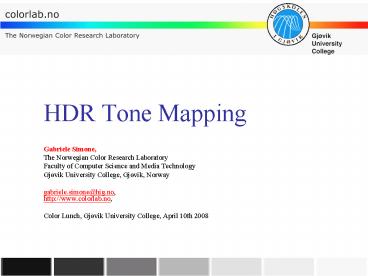HDR Tone Mapping
1 / 12
Title: HDR Tone Mapping
1
HDR Tone Mapping
- Gabriele Simone,
- The Norwegian Color Research Laboratory
- Faculty of Computer Science and Media Technology
- Gjøvik University College, Gjøvik, Norway
- gabriele.simone_at_hig.no, http//www.colorlab.no,
- Color Lunch, Gjøvik University College, April
10th 2008
2
Tone Mapping
- Unless we dont go out from RGB cube we have to
map HDR to LDR. This process is called tone
mapping. - The tone mapping goal is to compress the input
dynamic range for device visualization
reproducing as much as possible the visual
sensation of the scene. This goal can be
subdivided into the following sub-goals - Compress Dynamic Range
- Preserve Visibility
- Preserve Overall Contrast
- Preserve Saturation
- Recover Perceived Colors
- Brightness Matching
3
Tone Mapping (2)
- Spatial global operators
- Miller, TumblinRushmeier, Ferwerda, Reinhard and
Devlin - Wards histogram
- Ferschins exponential mapping
- Dragos logarithmic mapping
- Schlicks quantization
- Spatial local operators
- Chiu
- Rahman and Jobsons multiscale retinex
- Johnson and Fairchilds iCAM
- Frequency based operators
- Oppenheim
- Durands bilateral filtering
- Gradient domain operators
- Horn
- Fattal
Some of them have been developed/tested for a
specific encoding!
4
Miller
- Spatial global operator preserving the sensation
of brightness - Miller et al. assert that the visual equivalence
of an image after dynamic range reduction may be
modeled by keeping brightness ratios constant.
Thus, for two elements to be visually
quivalent to their compressed counterparts,
their ratios should be constant - Algorithm
- Convert an image to brightness values
- Determine the maximum brightness of the image
- Normalize images brightness values by dividing
each pixels brightness representation by the
images maximum brightness - Determine the display devices maximum brightness
- Calculate display brightnesses
5
Tone mapping comparison
6
Tone mapping comparison (2)
7
Tone Mapping Evaluation
- Given N tone mapped images
- Which one is less different from the orginal HDR?
- Which one is less different from original the
scene? - Which one is the most beautiful/preferred?
- ?Metrics analysis vs Perceptual experiments
8
Metric Analysis
- Image difference metrics
- RMSE
- S-CIELAB
- i-CAM
- SSIM
- UIQ
- Hue angle
- VDP
- Contrast, saturation, brightness
- Global measure
- Local ratio
9
Perceptual Experiments
- User
- expert vs non-expert
- Gender
- Age
- Environment
- controlled vs uncontrolled
- Comparison
- with reference vs no reference
- with score vs just the winner
10
Environment
- Controlled
- Dark room/reference illuminant
- Calibrated device
- Uncontrolled
- On the road/in your room
- On your personal display
11
Comparison
- With one or more references, tone mapped images
are compared to - Real scene
- HDR monitor display
- Multiexposure images
- With no reference, tone mapped images can be
compared - Singular rating
- Against each other
12
Comparison Methods
- Pairwise comparison
- Judging all combinations of a pair
- Ranking order
- Ordering the N images from the worst to the best
- K-opt comparison
- Judging all combinations of k-images
- For each step, best choice or ranking order































